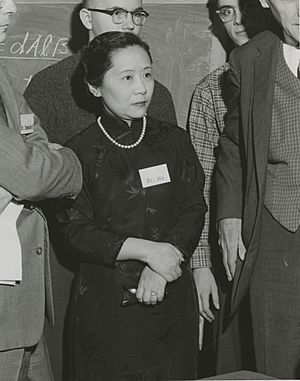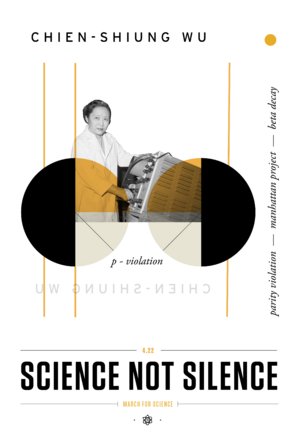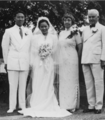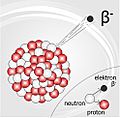Chien-Shiung Wu facts for kids
- This is a Chinese name; the family name is Wu.
Quick facts for kids
Chien-Shiung Wu
|
|
|---|---|

Chien-Shiung Wu in 1958 at Columbia University
|
|
| Born | May 31, 1912 Liuhe, Taicang, Jiangsu, Republic of China
|
| Died | February 16, 1997 (aged 84) New York City, United States
|
| Nationality | American |
| Alma mater | National Central University University of California, Berkeley |
| Known for |
|
| Spouse(s) |
Luke Chia-Liu Yuan
(m. 1942) |
| Children | Vincent Yuan (Chinese: 袁緯承) |
| Awards |
|
| Scientific career | |
| Fields | Physics |
| Institutions | Institute of Physics, Academia Sinica University of California at Berkeley Smith College Princeton University Columbia University Zhejiang University |
| Thesis | I. The Continuous X-Rays Excited by the Beta-Particles of 32P. II. Radioactive Xenons (1940) |
| Doctoral advisor | Ernest Lawrence |
Chien-Shiung Wu (Chinese: 吳健雄; May 31, 1912 – February 16, 1997) was a Chinese-American nuclear physicist. Her nicknames include the "First Lady of Physics", the "Chinese Madame Curie" and the "Queen of Nuclear Research".
Contents
Early life
Wu was born in May 1912 in Liuhe, a small town near Shanghai. Wu Zhongyi, her father, participated in the 1911 revolution against the Chinese Manchu dynasty. He was the founder of an all girls’ school in China. Educating girls wasn’t seen as important at that time. Wu went to that school until she was nine. After that, she went to the Soochow Girls’ School. She graduated in 1930. She was the best student in her class.
Studies
Wu went to college at Nanjing University. She studied physics there. She graduated in 1934. She spent one year teaching in a university. A year later, she went to study X-ray crystallography, which is the study of crystals. She did so at the National Academy of Sciences in Shanghai. A woman scientist who she worked with told her to go to study in the United States. She said this because China didn’t have a very good physics program. With the help of her rich uncle, she sailed to America in 1936.
Work
Wu started working on nuclear physics with a particle physicist named Ernest Livermore. She helped Emilio Segre. He won a Nobel Prize years later. During the same time, Japan invaded China. She didn’t hear from her family for years. She kept working.
Wu also studied the electromagnetic energy a particle gives off when it slows down. She also studied what happens when a uranium nucleus splits. For her work, she got a PhD in 1940. She became known as an expert on fission, which is the splitting of atoms.
She studied theories about atoms developed by Enrico Fermi. She ended up confirming one of his theories.
Wu continued with her work in physics in her later career. She faced a difficult hypothesis involving beta decay in 1963. Beta Decay was discovered by Richard Feynman and Murray Gell-Mann.
Disproving Parity
Chien-Shiung Wu helped overthrow the law of conservation of parity along with Tsung Dao Lee and Chen Wing Yang. For 30 years, parity was a universal law. The theory states that parity was when an event and its reflection were the same. Scientist believed that the conservation of parity applied to all events. Chien-Shiung Wu helped to disprove this theory. She found this when studying the electrons at a low temperature. Wu did most of the work. The Nobel Prize committee did not acknowledge her. They did recognize her two male partners who won the award.
Achievements
Many considered Wu's work on Fermi’s theory worthy of a Nobel prize. Her work was important but did not qualify for the prize. The two scientist she worked with on the theory about parity won a prize and she did not. People believed her work was not original.
She became the first woman to be the president of the American Physical Society. She was the first woman to receive the Comstock Award from the National Academy of Sciences. She was also the first woman to receive the Research Corporation Award. She received honorary degrees from over a dozen universities. Yale, Princeton and Harvard were some of the universities that recognized her work. Princeton gave her an honorary doctorate of science. She became the first woman to ever receive that.
Personal life
Wu married Luke Yuan in 1942. She taught at Smith College in Massachusetts. After that, she taught at Princeton. In 1944, she was recruited to do top-secret work on radiation detectors for the atomic bomb project called the Manhattan Project at Columbia University. She worked in a secret facility.
After World War II, Wu heard back from her family. They had all survived.
Wu retired in 1981. She died of a stroke on February 16, 1997, in New York. She was 86 years old. Her ashes were buried in the courtyard of her father's school.
Wu was an inspiration and a trailblazer. She didn’t let racism or sexism put her down. She kept working hard. She made some amazing discoveries. Her work wasn’t credited with a Nobel Prize but she made a huge impact on the world's knowledge of fission and quantum physics.
Honors, awards, and distinctions

- Elected a fellow of the American Physical Society (1948)
- Elected a member of the U.S. National Academy of Sciences (1958)
- Wu was the first woman with an honorary doctorate from Princeton University. The citation called Wu, "top woman experimental physicist in the world". (1958)
- Achievement Award, American Association of University Women (1959)
- Honorary degree from Smith College (1959)
- Wu won the Research Corporation Award, and dedicated the award to her teacher Hu Shih. The award is now housed in Nangang District, Taipei, where Hu's memorial is located. Wu spent two hours at the memorial, which was built after Hu suddenly collapsed and succumbed to a heart attack in the middle of a conference. Wu and her husband happened to be in that conference which was supposed to celebrate her career. (1958)
- John Price Wetherill Medal, The Franklin Institute (1962)
- American Association of University Women Woman of the Year Award (1962)
- First female to win the Comstock Prize in Physics, National Academy of Sciences (1964)
- Chi-Tsin Achievement Award, Chi-Tsin Culture Foundation (1965)
- Received an Sc.D. from Yale University (1967)
- Honorary Fellow of the Royal Society of Edinburgh (1969)
- Wu was bestowed an honorary L.L.D. from the Chinese University of Hong Kong. The citation stated, "The charming lady who is being honoured on this occasion is reputed as the world's foremost female experimental physicist ... Dr. Wu has made one of the greatest contributions to the knowledge of the universe." (1969)
- First Pupin Professor in the history of Columbia University, which went with a citation that described Wu as "the first lady of physics research" (1973)
- Scientist of the Year Award, Industrial Research magazine (1974)
- Honorary degree from Harvard University (1974)
- Tom W. Bonner Prize, American Physical Society (1975)
- First female president of the American Physical Society (1975)
- Honorary doctorate from Dickinson College (1975)
- First female to be honored with the National Medal of Science in Physics, which is the highest presidential honor for American scientists (1975)
- First person selected to receive the Wolf Prize in Physics (1978)
- Woman of the Year award from the St. Vincent Culture Foundation under UNESCO, which was presented by the president of Italy (1981)
- Honorary degree from the University of Southern California (1982)
- Honorary degree from the University at Albany, SUNY
- Honorary degree from Columbia University (1982)
- Lifetime Achievement Award from Radcliffe College, Harvard University
- Honorary professorship from the University of Padua, where Wu was asked to deliver a lecture in the same hall as the Renaissance astronomer Galileo Galilei (1984)
- Golden Plate Award of the American Academy of Achievement (1984)
- Wu received only the second Blue Cloud Award from the Institute of China for her outstanding contributions to cultural exchanges between China and America. (1985)
- To celebrate the centennial of the creation of the Statue of Liberty, 80 distinguished Americans were chosen to be honored with the Ellis Island Medal of Honor. Wu was the only physicist in a group that featured Rosa Parks, Gregory Peck, and Muhammad Ali, whom she took a photo with on the day of the ceremony. (1986)
- Awarded only the second mayor's award of honor from then-New York City mayor Ed Koch (1986)
- Honorary degree from National Central University (1989)
- Has an asteroid (2752 Wu Chien-Shiung) named after her (1990)
- Pupin Medal, Columbia University (1991)
- Wu was awarded the Science for Peace prize from the Ettore Majorana Centre for Scientific Culture in Erice, Italy "for her intense and vast scientific activity that has permitted the understanding of weak forces and for her engagement in the promotion of the role of women in science." The Ettore Majorana Centre, founded by the Sicilian government in 1963, is known worldwide for its scholarly meetings and graduate institutes with a membership of more than 56,000 scientists from over 100 nations. (1992)
- Elected one of the first foreign academicians of the Chinese Academy of Sciences (1994)
- Nobel laureates Chen-Ning Yang, Tsung-Dao Lee, Samuel C. C. Ting, and Yuan Tse Lee, together with other top physicists, established the Wu Chien-Shiung Education Foundation in Taiwan with the goal of promoting science to youths in Chinese communities worldwide. The foundation holds camps every summer that invite the top students in Science to participate, with many Nobel laureates of any ethnicity usually speaking in the camp's lectures. Competitions and face-to-face discussions are usually held with prestigious scholarships serving as the top prizes. Dialogues are all in Mandarin with professional translators who are hired to translate from other languages in real time. (1995)
- Inducted into the National Women's Hall of Fame (1998)
- Southeast University, one of the successors of National Central University, opened a college named in her honor. Wu was previously honored as an honorary professor in the university in 1990. (2003)
- The Taicang Normal School of Jiangsu Province was renamed into the "Suzhou Chien-shiung Institute of Technology" in her honor. (2004)
- First female nuclear and particle physicist to be honored with a street name at CERN called, Route Wu, and the second woman given the honor after Marie Curie (2004)
- Mingde Middle School held a memorial ceremony at Wu's cemetery located in the school campus. The 1,300 sq m cemetery was designed as a rounded viewing stand surrounded by flowers and trees, and was built by Southeast University in collaboration with the famous architect Ioeh Ming Pei. An educational activity titled "Promoting the Scientific Spirit of Chien-Shiung, and Be a Person of Moral Integrity" was launched among primary and middle school students across the city. Honorary president Jada Wu Hanjie was in attendance, as she habitually visited the school every month. The ceremony was sponsored by the Taicang municipal government. (2012)
- The Suzhou Chien-shiung Institute of Technology celebrated Wu's 100th birthday with a 23-foot bronze statue that weighed 8 tons at the center of the school in front of Xinjing lake, where it is surrounded by pine trees and cypresses. It was designed by Professor Zhang Yonghao and was based on her visit to the White House in the 1970s. Together with the statue was the inauguration of the Chien-Shiung Wu museum in the school. Other monuments, structures, and edifices include a stone inscription of Wu's biography, a large park called the Knowledge Square, and plenty of other tributes. (2012)
- Portrait was added into New York City Hall (2020)
- For the centennial of the 19th amendment that gave suffragettes the right to join fair elections, Time magazine released the 100 Women of the Year. This list was to represent each woman of the year from 1920 to 2019. The woman of the year would be the female counterpart to the disused, so-called "man of the year" that Time changed to "person of the year". Wu was on the magazine cover where she was called the woman of the year in 1945 for her crucial role in the Manhattan Project. This was the same year when US President Harry Truman was labeled man of the year for fully utilizing the very bomb Wu built, which he tested on Japan. (2020)
- Wu became only the eighth full-time physicist to be honored with a United States Postal Service postage stamp. The others include John Bardeen, Feynman, Fermi, Millikan, Einstein, and Josiah Gibbs. (2021)
- The United States Postal Service issued a Forever stamp featuring a portrait of Wu, designed by Ethel Kessler with art from Kam Mak. (2021)
Images for kids
-
Wu's father Wu Zhong-Yi was a member of the group of rebels during the revolution that ended China's last dynasty and started the new republic. This period of dramatic social change influenced the feminist views of Wu and her father.
-
Wu (right) in an outing with Margaret Lewis in Berkeley, California
-
Chien-Shiung Wu and Luke Yuan (left) at the home of Mr. and Mrs. Robert Millikan (right) on their wedding day
-
Mao Zedong and Chiang Kai-shek would fight for the fate of the country immediately after the united Chinese forces won the second world war.
-
The experiments of Columbia University physicists (left to right) Wu, Y.K. Lee, and L.W. Mo confirmed the theory of conservation of vector current. In the experiments, which took several months to complete, proton beams from Columbia's Van de Graaff accelerator were transmitted through pipes to strike a 2 mm boron target at the entrance to a spectrometer chamber.
See also
 In Spanish: Chien-Shiung Wu para niños
In Spanish: Chien-Shiung Wu para niños















